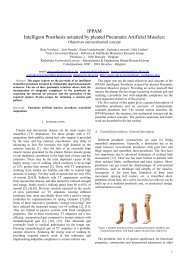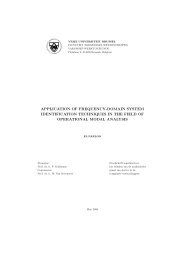VRIJE UNIVERSITEIT BRUSSEL Acoustics - the Dept. of ...
VRIJE UNIVERSITEIT BRUSSEL Acoustics - the Dept. of ...
VRIJE UNIVERSITEIT BRUSSEL Acoustics - the Dept. of ...
Create successful ePaper yourself
Turn your PDF publications into a flip-book with our unique Google optimized e-Paper software.
34 CHAPTER 3. MEASURING SOUNDconverted in an electric signal. This is amplified and optionally filtered in <strong>the</strong>frequency domain. The electrical signal is <strong>the</strong>n read out by <strong>the</strong> measuringdevice. This reading can be done in several ways (digital display, computerscreen, analog display.The microphone is <strong>the</strong> critical element in every measuring system forsound. The microphone detects <strong>the</strong> sound pressure variations and converts<strong>the</strong>m into electrical signals. This can be done in several ways:Ceramic or piezoelectrical microphones. The working principle <strong>of</strong>ceramic or piezoelectrical microphones is based on <strong>the</strong> properties <strong>of</strong> <strong>the</strong>piezoelectrical material. This material generates an electrical voltagewhen mechanical pressure is applied on it. Ceramic microphones arerobust and not sensitive to moisture and o<strong>the</strong>r environmental impacts.O<strong>the</strong>r advantages are <strong>the</strong>ir relatively low cost and <strong>the</strong> fact that noexternal voltage source is necessary.Condenser microphones. The condenser microphone is used to executeprecise measurements. Condenser microphones make use <strong>of</strong> twoelectrically chargedplates withanair gapinbetween. One<strong>of</strong><strong>the</strong>platesis a light membrane that moves under influence <strong>of</strong> <strong>the</strong> incoming soundwaves. Figure 3.1 displays a construction <strong>of</strong> such a microphone. Between<strong>the</strong> membrane and <strong>the</strong> base plate an electrical charge is createdby a voltage supply. Due to <strong>the</strong> incoming sound wave <strong>the</strong> distancebetween <strong>the</strong> base plate and membrane changes, casing <strong>the</strong> capacityto change. This results in variations on <strong>the</strong> voltage over <strong>the</strong> microphonethat that proportional with <strong>the</strong> incoming pressure (see Figure3.2). Condenser microphones can be designed to have a sensitivitythat does not change much over time and to have a frequency responsethat is very flat (<strong>the</strong> sensitivity is <strong>the</strong> ratio <strong>of</strong> <strong>the</strong> measured tensionover <strong>the</strong> sound pressure, this value is <strong>of</strong> <strong>the</strong> order <strong>of</strong> a few mV/Pa).Moreover <strong>the</strong>y are very insensitive to temperature changes. Due tothis stability condenser microphones are designated to use for precisionmeasurements. Since an notable polarisation tension needs to be appliedover <strong>the</strong> capacitor, a to high humidity can give problems. The use<strong>of</strong> a heating element can present a solution to this problem, if lengthymeasurements need to be conducted.Electret microphones an electret is a polymer film with an electricalcharge bound to <strong>the</strong> molecules. An electret condenser microphone ismade by applying <strong>the</strong> electret on a perforated metal plate, and shieldit <strong>of</strong>f on <strong>the</strong> front side with a plastic membrane on which a thin metal
















